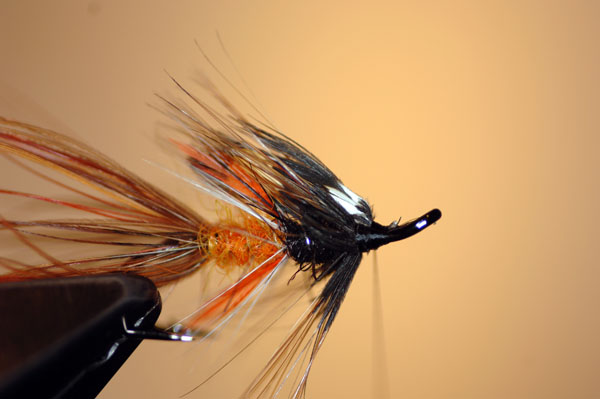
The Usk Grub
This pattern has earned a reputation around the world for its fish taking ability.
As I understand it is the first recorded tying of a shrimp pattern and was the basis for the shrimp patterns of Ireland and not the other way round.
The dressing is as follows:
- Hook: Treble, double or single (your choice- mines a double)
- Silk: Black
- Tag: Silver oval tinsel
- Tail: The ruddy red flank feather of a golden pheasant.
- Rib: Silver oval tinsel
- Body: In 2 halves. Rear orange and amber seal’s fur mixed 2/3 to 1/3 Front half black seals fur.
- Veilings: Over rear 1/2 of the body orange cock hackle points. The original was Indian crow some just put in a turn of cock hackle.
- Middle Hackle: In between the body halves a single turn of white cock hackle.
- Front Hackle: Furnace Cock hackle (A red game with a black centre)
- Wings: Two jungle cock eye feathers tied back to back extending only halfway down the body.
- Head: Black.
First, attach your fly in the vice and attach the silk with a jam knot. Then attach the ribbing material.
I like to attach the ribbing on a double to the side of the shank so as to ensure it is gripped well and will not pull out.
Form the tag by wrapping the tinsel down towards the hook bend with four to five turns of the ribbing. Then take the tinsel and wrap it under and between the hook barbs and pull it tight over the previous wrapping. Tie-down the waste on top of the hook shank.
Note you can only do this on doubles. For singles and trebles, you need to wind the tinsel back up towards the head and secure it then again on the shank.
The advantage with the double is that the tinsel will hold tight the tag and will ensure the most secure fit.
Take the Golden Pheasant red flank feather and with the aid of a set of hackle pliers double the fibres over so that they are on one side of the quill. Be careful as this feather can often break.
Now reverse it and tie it in against the tag by its tips so the fat end of the quill bends over the rear of the hook.
Take hold of the quill stem and wind it in touching turns down the hook shank. The first turn should be tight up against the tinsel and then each turn abuts the quill. This will ensure that the fibres flare and so give the fly movement in the water.
Tie off and remove the waste quill.
Now tie in the ribbing material again along the side of the hook shank for a stronger hold.
The rear half of this fly is orange-amber seals fur. The mix should be 2/3 rds orange to 1/3rd amber. This will give you the right colour.
Dub on this mix to the silk and wind it on to the halfway point of the shank.
Rib this part of the body with three turns of tinsel secure and remove the waste.
Select two small orange cock hackle tips and tie them in as veiling which means that they need to lie over and under the rear half body and do not go beyond the tag.
The next part is to take a white cock hackle and double it over as before. Tie in by the tip and make one turn of it and secure with the thread and remove the waste.
Now reattach the silver oval tinsel.
Now dub on the black seals fur to the silk and wind it on the hook shank and wind the rib as the rear half.
Take the furnace hackle and again double this over and tie in by the tips and wind on the head or collar hackle.
Now comes the difficult bit in that the jungle cock wings have to be tied in and they do not always behave. get a matching pair one from each side of the cape and place them back to back. Measure the length of the wing and it should just come over the mid hackle. With a pinch and loop technique secure them to the hook shank. They should lie upright and not twist. If they do twist then unwrap and try again. If it continues to twist then take a dubbing needle and grasp the wings in between the thumb and forefinger of the right hand. With the left then take the dubbing needle and rub gently at the rear base of the JC feathers. This will encourage them to lie properly.
I know it is a bit of a potch but it will come right in the end.
As you can see the wing lays down through the collar/head hackle.
Now whip finish and varnish the head.
It is not the easiest pattern to tie because of the wing but do try and persevere and don’t put in a delta wing of JC feathers because then it almost becomes a Bann special.
If you get problems to contact the forum.
Tight lines
















